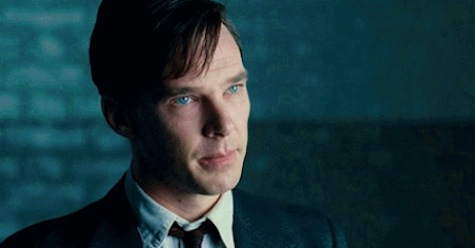I am in control because I know things you do not know. But if you choose to stay, remember, you chose to be here. Pay attention.
The Voight-Kampff machine is a fictional biometric measuring device used in tandem with a test bank of psychological profiling questions “designed to evoke an emotional response.” In Blade Runner, this test is given to those who are believed to be replicants, the artificially intelligent entities created to work under dangerous or unpleasant conditions in early 21st-Century off-Earth colonies who are, to any but the most well-trained observers, indistinguishable from humans.
In 1951 in The Imitation Game, Alan Turing (Benedict Cumberbatch), is interrogated by a detective, Nock, about his blank military service record and alleged homosexuality, discovered as a result of investigating a burglary at Turing’s home. (Turing’s arrest actually came in 1952, a needless historical inaccuracy.) The interrogation room is colored in a blue hue similar to the lighting in the room where Leon is questioned about flipped-over turtles and his mother at the beginning of Blade Runner. Nock, learning of Turing’s work, specifically a recent paper describing the “imitation game” (a modification of which is known as the Turing test) that would attempt to tell a human from a machine intelligence, asks him, “Do machines think?” He is nonplussed with his own query; this has nothing to do with military records, spying, or sexual orientation, does it?
The fictional cipher of Nock questioning a very real Turing about the secrets he and his government have hidden, in a setting reminiscent of the interrogation of an intelligent machine that would barely exist in fiction (let alone its potential in reality) without Turing’s foundational work in computing, World War II codebreaking, and artificial intelligence, underlies the Philip-K-Dickian twists one must go through in parsing the truth from fiction, on the levels of historical accuracy and character secrecy, in The Imitation Game.
The Imitation Game is a fictionalized biography film about the life of Alan Turing, one of the most brilliant and indispensable mathematicians of the 20th Century, and one of the founders of modern computing and artificial intelligence, based on Andrew Hodges’ biography Alan Turing: The Enigma. The action takes place primarily during the development of the mathematics and machinery used in defeating the seemingly-unbreakable German encryption code Enigma during World War II, and Turing’s treatment at the hands of the British government in the early 1950s when arrested for the crime, at that time, of homosexual conduct on British soil. It also briefly visits Turing’s boarding school period, during which he discovers his love of mathematics and his sexuality.
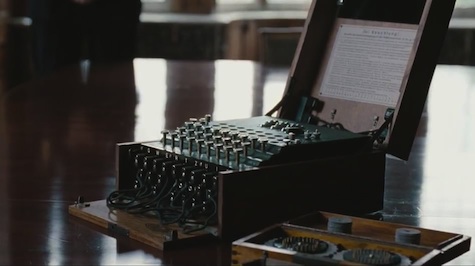
The film cuts its three story lines into a Cloud Atlas-like chronology: Alan is in Manchester in 1952, dealing with the police. Alan is in Bletchley Park in 1939, beginning to develop the codebreaking machine (called a bombe; film-Turing names theirs Christopher) to crack the German Enigma code during WWII. Alan is a schoolboy at Sherborne in 1930, being severely bullied by his peers, and developing a cryptanalytic and cryptoromantic relationship with Christopher Morcom, until Morcom’s young demise. Alan is in Bletchley in 1941, finally discovering the solution to the Enigma, and deducing how to use this knowledge. Alan is in Manchester in 1954, suffering with his choice of sentencing.
Nock initially means to shoot Turing down, believing him a Soviet spy (this is the second time, chronologically, that this happens in the film). When it becomes clear to Nock that not only is Turing not a spy, but a war hero, brilliant mathematician, and accused homosexual, we have had our fill of long-form flashbacks and can remain in the painful present.
Until then, we as viewers are a bit unstuck in Turing’s continued struggle to deal with other intelligent, sometimes violent, beings. If only they would say what they mean, instead of speaking cryptically. If only we didn’t think differently, and speak differently, we could understand each other.
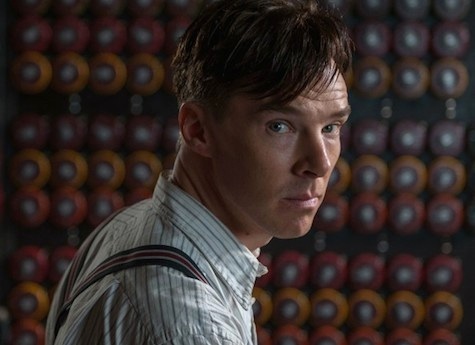
Secrets hidden in plain sight is a pervasive notion in The Imitation Game. The German encrypted code is simply floating in the air, readable as nonsense characters to anyone who scans the transmission. Young Alan and Christopher pass notes in class, intercepted by a schoolteacher, but who fails to decode and read the transmitted message: “Only Turing would pass notes in gibberish.”
The problem is in those red pill takers, whether intentionally or unwittingly, that just need to solve puzzles. When you solve a puzzle, crack some code, uncover a secret that someone’s been trying to keep, your reward is information.
And information without action is pain.
Sometimes we can’t do what feels good.
Sometimes we have to do something logical.
D ZQAE PZR
Young Alan knows Christopher will miss him for the two weeks they are separated, and cannot deliver an encoded message of affection to him once he hears the devastating news that Christopher has died of TB complications while away (which Turing should have known about). Bletchley Alan, once his team finally cracks the Enigma code, convinces them that they must not prevent an attack due to occur in minutes, since saving those particular British lives means informing the Germans that their privacy is broken, even though one of the team has a brother on a transport in that battle.* Nock is powerless once he discovers that the crime Manchester Alan has committed is not espionage, but “gross indecency”, and must arrest him for that instead.
* A throwaway line between Turing and Menzies, about using “statistics” to minimize the losses and maximize the benefits of the cracked Enigma code, while minimizing the chance that the Germans would figure out that the Allies had indeed cracked the code, hints at another entire field of mathematics and statistics developed during WWII: sequential analysis.

Sometimes the price of uncovering hidden truths is knowing that you cannot use your newfound knowledge in a way that will help you or others. Some secrets must remain secrets. The secrecy of the Enigma crack lasted well beyond the war—Churchill called the workers at Bletchley Park “the geese that laid the golden eggs and never cackled.” The secrecy of Turing’s love life, however, likely cost him, and us, his life.
Some advice about keeping secrets: it’s much easier if you don’t know them in the first place.
The acting is roundly brilliant; Cumberbatch, Keira Knightley, Mark Strong, Matthew William Goode, and Charles Dance all excel in embodying the Hut 8 players. Cumberbatch’s penchant for playing brilliant, barely-sympathetic misanthropes (Sherlock, Khan, Smaug) snags slightly on his occasional attempt at making Turing a bit more familiar. Knightley, who plays Joan Clarke, Turing’s crossword-puzzle hire onto the Enigma project, and later, briefly, fianceé of convenience, is wasted on some woman-understands-misunderstood-man dialogue rather than on developing Clarke’s own fascinating backstory. Goode, playing Hugh Alexander*, sometimes mirrors the acting choices of Josh Lucas’ Martin Hansen, rival of John Nash, from A Beautiful Mind, as the suave, not-as-brilliant and slightly-fed-up counterpart. This is especially apparent in the crucial scene at a Bletchley bar, where the buildup to and execution of a chat-up result in the prime insight needed to finally defeat Enigma, much as the “governing dynamics” monologue in a bar in ABM helps with film-Nash’s breakthrough.
* Film-Alexander is a screenwriting conflation of the real Alexander, who was also a chess champion before and after Bletchley, and Gordon Welchman, who actually came up with the diagonal board configuration used in the bombe.
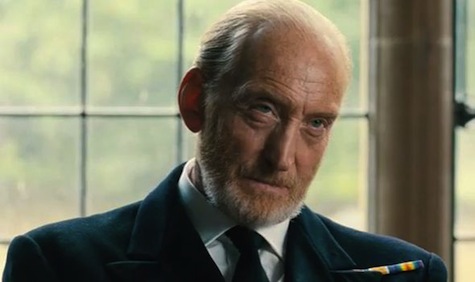
Charles Dance’s villains bubble up a bit strongly in Commander Denniston, however; everyone at Bletchley is working on the same side. Alex Lawther and Jack Bannon bring the young Alan and Christopher into fine relief, and provide a backdrop for the deeply-set pain in Turing’s heart. Alexandre Desplat’s soundtrack moves seamlessly between time periods and tragedies, and Morten Tyldum’s direction isn’t felt so much not-felt, as though this life was merely unfolding in front of us.
Something I did expect to see that did not appear in the film was this syllogism, written in 1952 to Turing’s friend Norman Routledge shortly before his conviction:
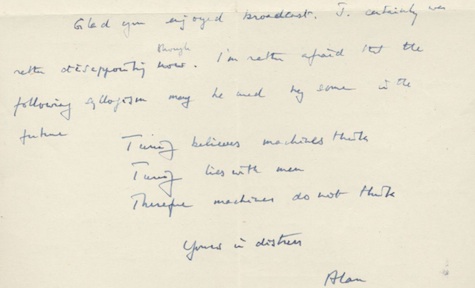
I’m afraid that the following syllogism may be used by some in the future.
Turing believes machines think
Turing lies with men
Therefore machines do not thinkYours in distress,
Alan
I felt the lack of this historical item particularly: it shows that Turing did have friends, and was not a caricature misanthropic “lone genius” working in solitary in his professorial estate when not engaging prostitutes for their services, as the film seems to imply in the opening 1952 segments. While certainly a difficult person to work or deal with, his level of arrogance did not necessarily extend to the Sherlockian levels that Tyldum and Cumberbatch give him in the opening scenes. However, it is possible that his despair did reach the levels portrayed in the 1954 ending.
At the end of the war, there is one thing left to do in a house of secrets: burn everything.
Of course I chose this.
If Germany’s political sphere was not as it was in the 1920s and ’30s, perhaps we would not have had Turing to thank for the rise of modern computing. If Britain’s cultural sphere was not as it was in the 1950s, perhaps we would have had Turing quite a bit longer to develop his theories of artificial intelligence and morphogenesis. But the light that burns twice as bright burns half as long.
Michael Carlisle is an Assistant Professor of Mathematics at Baruch College, City University of New York. His work in probability theory helps answer the ages-old question, “How long does it take to frost a donut with an out-of-control icing gun?” As far as he knows, he is not a robot. Want to judge? Ask him a question.










